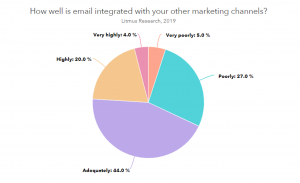Customers and communication form the core of all marketing strategies. Both of them are interrelated and combining them could bring in big overall improvements in areas like customer support. Today, we will discuss how two of the most powerful tools, email marketing, and CRM can be harnessed for flawless customer support. Email marketing is considered the most effective channel with an ROI of $44 per every dollar invested, making it four times more effective than any other digital marketing channel. On the other hand, CRM tools facilitate the capturing of customer data and making sense of it to improve your outreach efforts. In this blog, I am going to discuss how you can harness the power of a CRM tool integrated with email marketing software to render a seamless client support experience. Read the article ahead to know more on the topic.
How Email Marketing And CRM Fit In Together
Both CRM and email marketing have individual benefits that act in synergy with each other and provide better strategic advantages to businesses. CRM helps acquire behavioral data along with demographics and psychographics extensively that can be used by email marketing tools for running targeted campaigns. It also helps optimize automation workflows and implement email marketing strategies that would otherwise consume a lot of staff hours of both email developers and marketers.
The CRM data can help develop and integrate dynamic content fields for your HTML email templates on an individual basis for your subscribers. You can also get access to a completely new pool of metrics that tracks user interactions to provide behavioral insights and potential value additions that improve your customer experience by leaps and bounds.
Advantages Of Combining The Power Of CRM And Email Marketing
In this section, I am going to share a few points on harnessing the synergy of both these tools to execute marketing strategies:
Smarter Segmentation
CRM software allows you to patch 360-degree details regarding your subscribers, including their location, gender, income range, age group, interests, and average order value, which can be combined with email metrics like CTR and open rates. When you have such extensive information regarding your subscribers, you can set up automation workflows that resonate with different user segments’ needs.
For instance, a group of new customers using your products might require personal assistance for solving a query, while older customers may only require a few tips penned down in an email. Identifying them and reverting with an appropriate response saves you from annoying your customers. Novice users might get overwhelmed after seeing new terms while allocating time for a one on one consultation might not be worth their time. You can expect smarter segmentation that allows you to filter contacts placed on their interest for a particular product/service boiled down to an individual level instead of generic audience segments.
Advanced Personalization
Like segmentation, you will get top-notch personalization features by combining the two. Since you can integrate your email marketing efforts with other channels, you can expect a high degree of personality as well as better ROI, a factor lacking in most of the business, as shown in the below infographic:
This means that you can provide a seamless reader experience across multiple platforms with interactions of them, helping you improve your overall email marketing strategy. If your customers tried contacting you on a social media platform for a certain query, you could ask if they were satisfied with the interaction later on by email. Here’s an example of gathering feedback after client servicing by Dropbox:
Integrating Metrics With Automation
CRM tools can help interpret readers’ behavioral aspects that impact email metrics such as CTR, conversion rate, forwarding rate, spam rate, and unsubscription rate to understand how your emails impact them. If subscribers are responding, you can ask for feedback and offer incentives for re-engagement. On the flip side, it also ensures that the customers who go inactive for the sake of receiving special offers are provided with ladder discounts to prevent any malpractice.
Optimized Transactional Emails
CRMs help understand the user intent in more detail, which in turn improves the quality of messages sent. This can be useful, especially when the sales cycle is considerably longer, and your customers expect varying content as they move forward into the sales funnel. Since the data regarding the past queries of your customers is available, you can improve the customer servicing quality by providing all the necessary details to your support staff on a real-time basis without making your clients describe everything in detail.
Over To You
Email marketing is indeed one of the most powerful outreach tools, but CRM acts as an extension of its capabilities. This you develop more meaningful relationships with your subscribers and understand how your efforts work with a variety of buyer personas. They also help identify new opportunities and retain customers with minimal cost additions. I hope you find this article on honey Singh the power of email marketing and CRM useful for your future endeavors.















